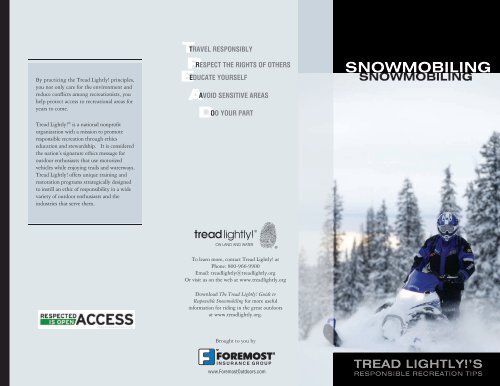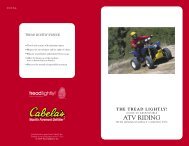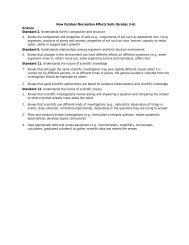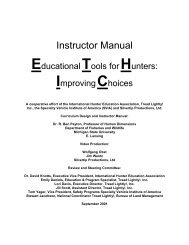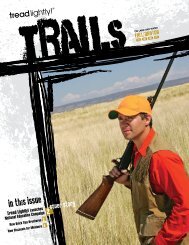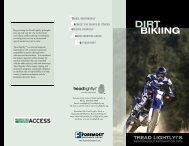snowmobiling - Tread Lightly
snowmobiling - Tread Lightly
snowmobiling - Tread Lightly
Create successful ePaper yourself
Turn your PDF publications into a flip-book with our unique Google optimized e-Paper software.
By practicing the <strong>Tread</strong> <strong>Lightly</strong>! principles,you not only care for the environment andreduce conflicts among recreationists, youhelp protect access to recreational areas foryears to come.<strong>Tread</strong> <strong>Lightly</strong>! ® is a national nonprofitorganization with a mission to promoteresponsible recreation through ethicseducation and stewardship. It is consideredthe nation’s signature ethics message foroutdoor enthusiasts that use motorizedvehicles while enjoying trails and waterways.<strong>Tread</strong> <strong>Lightly</strong>! offers unique training andrestoration programs strategically designedto instill an ethic of responsibility in a widevariety of outdoor enthusiasts and theindustries that serve them.TREADTRAVEL RESPONSIBLYRESPECT THE RIGHTS OF OTHERSEDUCATE YOURSELFAVOID SENSITIVE AREASDO YOUR PARTSNOWMOBILINGSNOWMOBILINGON LAND AND WATERTo learn more, contact <strong>Tread</strong> <strong>Lightly</strong>! atPhone: 800-966-9900Email: treadlightly@treadlightly.orgOr visit us on the web at www.treadlightly.orgDownload The <strong>Tread</strong> <strong>Lightly</strong>! Guide toResponsible Snowmobiling for more usefulinformation for riding in the great outdoorsat www.treadlightly.org.Brought to you byTREAD LIGHTLY!’SRESPONSIBLE RECREATION TIPS
TRAVEL RESPONSIBLYTravel responsibly on designated roads, trailsand areas.aa Travel only in areas open to <strong>snowmobiling</strong>.aa Avoid trails with inadequate snow cover.aa When climbing a hill, approach the summit withcaution.aa Do not ride off cornices.aa Avoid riding on frozen waterways and lakes.aa When approaching a corner, reduce your speed toavoid sliding.aa Lean into turns with your upper body to enhancethe sled’s maneuverability.aa Cross roadways at a 90-degree angle.aa Pump your brake when going downhill to avoidlocking the brakes.aa Be aware of unmarked hazards or obstacles hiddenbeneath the snow.aa Travel at reasonable speeds.aa When riding at night, use extra caution.aa Wear reflective clothing at night and reduce yourspeed.aa Do not accommodate extra riders over thedelineated limit.aa Comply with signs and respect barriers.aa Buddy up with two or three riders, reducing yourvulnerability if you have an accident or breakdown.aa Avoid riding in potential avalanche areas. Useterrain to your advantage, avoiding steep slopes,cornices, and gullies or depressions. Periodicallycheck for clues to an unstable snowpack.Remember, one rider at a time on slopes.aa Listening to headphones or ear buds can makeit difficult to hear and communicate with otherrecreationists. In some areas it is illegal to operatesnowmobiles with both ears covered.aa Don’t mix riding with alcohol or drugs.RESPECT THE RIGHTS OF OTHERSRespect the rights of others, including privateproperty owners, all recreational trail users,campers and others so they can enjoy theirrecreational activities undisturbed.aa Be considerate of others on the trail.aa Ride single file, keep to the right and pass on theleft only when the trail is clear.aa When stopping on the trail, pull your sled as farright and off the trail as possible.aa Yield the right-of-way to skiers, snowshoers andthose passing or traveling uphill.aa Use common <strong>snowmobiling</strong> signals tocommunicate with your group and other riders.aa If crossing private property, be sure to askpermission from the landowner(s).EDUCATE YOURSELFEducate yourself prior to a trip by obtainingtravel maps and regulations from publicagencies, planning for your trip, takingrecreation skills classes, and knowing how tooperate your equipment safely.aa Obtain a map—motor vehicle use map whereappropriate—of your destination and determinewhich areas are open to snowmobiles.aa Make a realistic plan and stick to it. Always tellsomeone of your travel plans.aa Contact the land manager for area restrictions,closures, and permit requirements.aa Always check the weather forecast and avalancheconditions.aa Understand how to operate your vehicle and itscontrols.aa Prepare for the unexpected by packing a smallbackpack full of emergency items.aa Wear a helmet, eye protection, and other safetygear.aa Layer clothing and wear a durable waterproof outershell and footwear.aa If you suffer a breakdown, stay with your sled andstay on the trail.aa Make sure your snowmobile is mechanically up totask. Be prepared with tools, supplies, and a spillkit for trailside repairs.aa Take a snowmobile safety course.aa Take an avalanche class. It provides skills onassessing snow conditions, performing rescues andusing safety equipment.aa Wear an avalanche transceiver, shovel, and probeon your body at all times in avalanche terrain.aa If a person develops hypothermia, warm the personup by rubbing them vigorously and getting theminto dry clothes. Give them warm non-alcoholicliquids.AVOID SENSITIVE AREASAvoid sensitive areas such as meadows,lakeshores, wetlands and streams. Stay ondesignated routes.aa Low snow, don’t go. A snowmobile’s spinningtracks damage plants and soils just below thesnow’s surface. Hill climbing in these conditionsis especially damaging.aa Do not disturb historical, archeological, orpaleontological sites.aa Be respectful of wildlife’s wintering habitats.aa Avoid “spooking” livestock and wildlife and keepyour distance.aa Motorized and mechanized vehicles are notallowed in designated Wilderness Areas.DO YOUR PARTDo your part by modeling appropriatebehavior, leaving the area better thanyou found it, properly disposing of waste,minimizing the use of fire, avoiding thespread of invasive species, and restoringdegraded areas.aa Carry a trash bag on your snowmobile and pickup litter left by others.aa Pack out what you pack in.aa Dispose of all sanitary waste properly by packingit out or bury it 6 to 8 inches deep in soil.aa To minimize harmful emissions, keep yourengine in tune.aa Prevent unnecessary noise created by a poorlytuned vehicle or revving your engine. Use propersilencers on exhausts, which meet regulatorydecibel levels.aa Build a trail community. Get to know othertypes of recreationists that share your favoritetrail.


